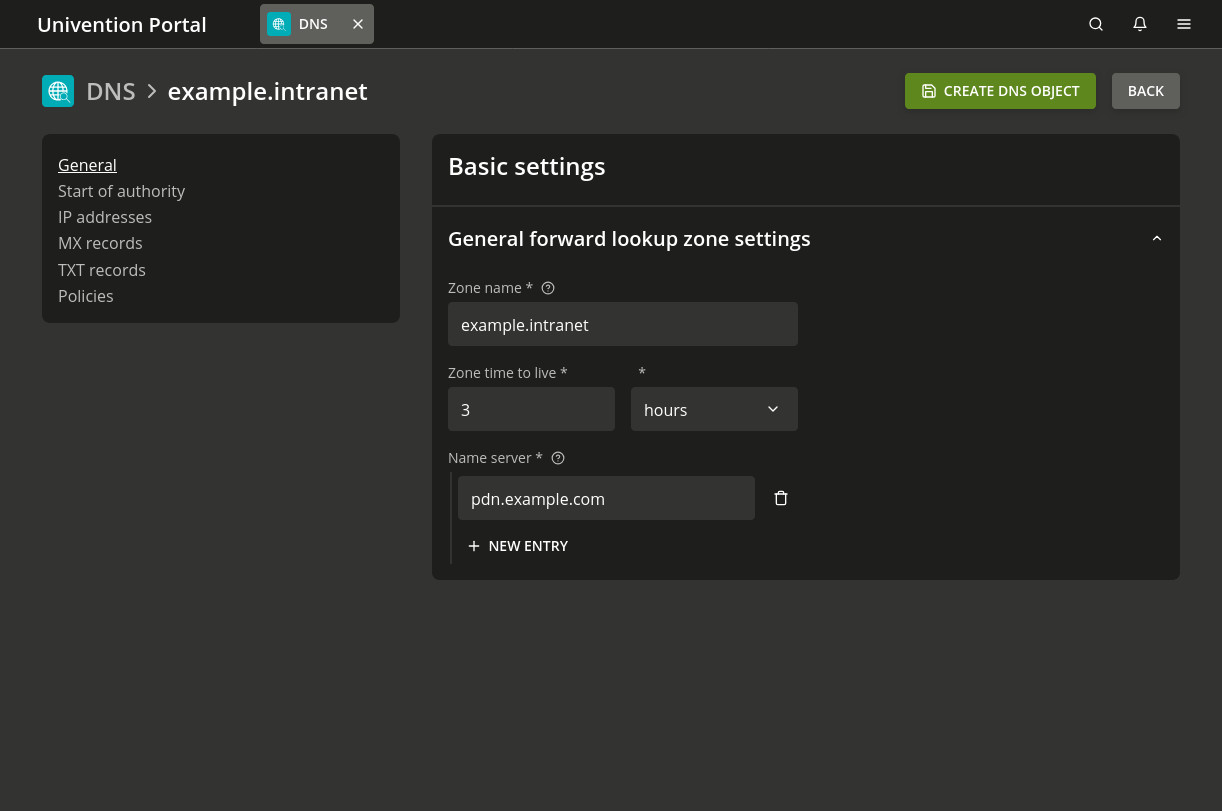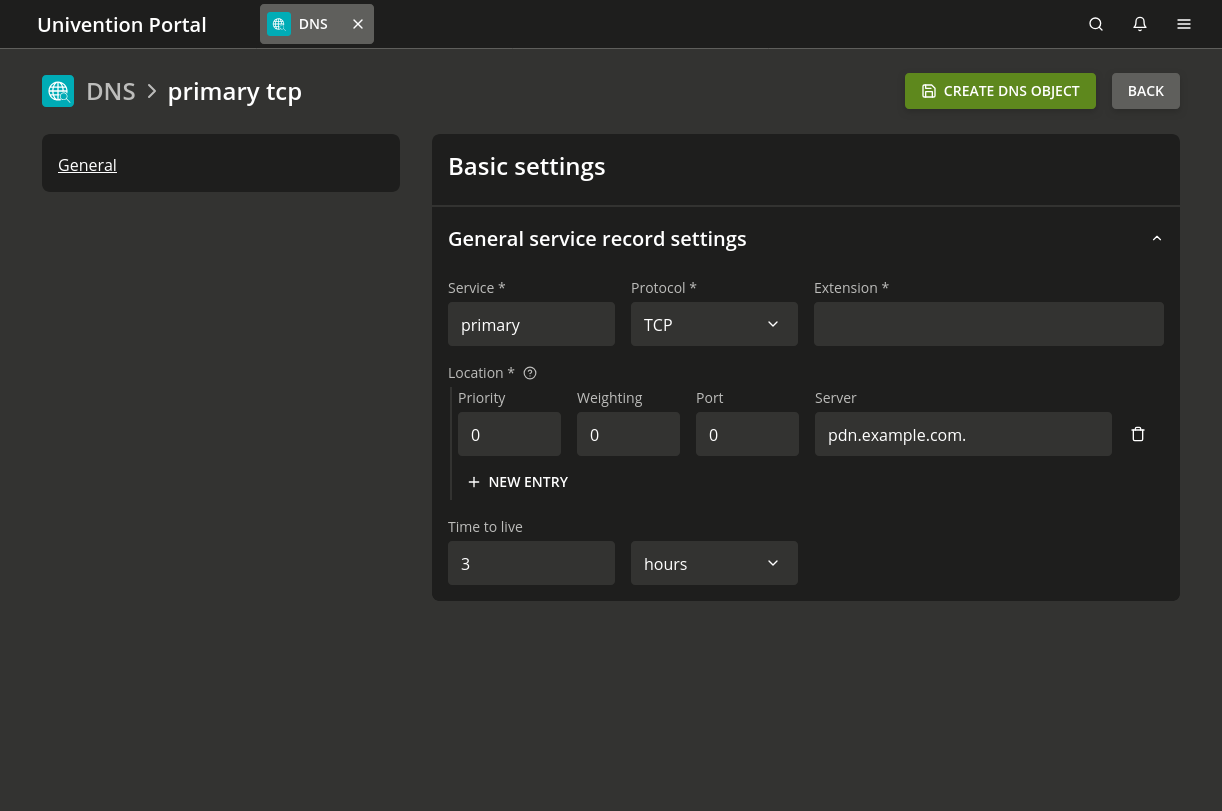8.3. DNS module#
Deployment — Kubernetes & UCS appliance
The DNS management module appears in both deployments. However, administrators mostly use it in the context of the UCS appliance with its network management capabilities.
Nubus offers the DNS management module to manage forward and reverse lookup of hostnames and IP addresses. In the module, you can manage the following aspects around DNS:
Zones:
Records:
This section provides a reference for the fields used in the DNS management module.
Nubus stores DNS information in the cn=dns,base DN container.
It saves forward and reverse lookup zones directly in the container,
and records in the respective zones, such as pointer records.
Important
In the DNS management module, always use the relative or the fully qualified domain name (FQDN)
in the fields for computers, and not the computer’s IP address.
Always end the FQDN with a period (.),
otherwise DNS adds the domain name.
You find the DNS management module in the Domain category in the Management UI. The left column of the DNS management module shows a list of forward and reverse lookup zones. To add a DNS object to a zone, for example an alias record to a forward zone, select the corresponding zone. To create a DNS object in the selected zone, click Add.
To create a forward or reverse zone, select All DNS zones, and click Add. DNS objects within zones label the zone as superordinate object.
Each DNS zone has at least one authoritative, primary DNS server whose information governs the zone. Subordinate DNS servers synchronize themselves with the authoritative server through zone transfers. The DNS terminology calls entries that define a zone, Start Of Authority or SOA records. To manage the SOA records for the zones, see the following sections:
8.3.1. Forward lookup zone#
Forward lookup zones contain information that the DNS uses to resolve DNS names into IP addresses. You manage forward lookup zones in the DNS management module.
To add a forward lookup zone, select All DNS zones and choose . Fig. 8.1 shows the configuration dialog for a DNS forward zone. It has the following tabs:

Fig. 8.1 Configuration of a DNS forward lookup zone in the DNS management module#
8.3.1.1. General tab - DNS forward lookup zone#
- Zone name
The complete name of the DNS domain that the zone is responsible for. The domain name must not end in a
.in zone names.- Zone time to live
The time to live specifies how long other DNS servers cache the DNS information.
- Name servers
The fully qualified domain name with a
.at the end of the relative domain name of the responsible name server. The first entry in the line is the primary name server for the zone.
8.3.1.3. IP addresses tab - DNS forward lookup zone#
- IP addresses
Specify one or more IP addresses that the DNS server returns when resolving the name of the zone. Microsoft Windows clients in AD compatible domains query these IP addresses.
8.3.1.4. MX records tab - DNS forward lookup zone#
- Priority
A numerical value between 0 and 65535. If several mail servers are available for the MX record, the requesting clients attempt to engage the mail server with the lowest priority value first.
- Mail server
The mail server responsible for this domain as fully qualified domain name with a
.at the end. Only use canonical names and no alias names.
8.3.1.5. TXT records tab - DNS forward lookup zone#
- TXT record
A descriptive text for the zone. TXT records must not contain umlauts or other special characters.
8.3.2. Reverse lookup zone#
Reverse lookup zones contain information that DNS uses to resolve IP address to host names. You manage reverse lookup zones in the DNS management module.
To add a reverse lookup zone, select All DNS zones and choose . The management module for reverse lookup zones has the following tabs:
8.3.2.1. General tab - DNS reverse lookup zone#
- Subnet
The IP address of the network for which the reverse lookup zone applies.
- Example
If the network consists of the IP addresses
192.0.2.0to192.0.2.255, you enter192.0.2here.
- Zone time to live
The time to live specifies how long other DNS servers cache the DNS information. The value is in seconds.
8.3.3. CNAME alias records#
You can manage CNAME records, also know as alias records, in the DNS management module. To create a CNAME record, select the forward lookup zone in the left column, and click .
- Alias
The alias name as fully qualified domain name with a
.at the end or as a relative domain name that must point to the canonical name.- Canonical name
The canonical name of the computer that the alias points to. The value is a fully qualified domain name with a
.at the end or a relative domain name.
8.3.4. A/AAAA host records#
You can manage A/AAAA host records in the DNS management module. To create a A/AAAA record, select the forward lookup zone in the left column and click .
When you add or edit a computer object, the Computer management module automatically creates or edits the A/AAAA record. For more information, see General tab - Computer management.
- Hostname
The fully qualified domain name with a
.at the end or the relative domain name of the name server.- IP addresses
The IPv4 and/or the IPv6 addresses to which the host record refers.
- Time to live
The time to live specifies how long other DNS servers cache the DNS information.
8.3.5. Service records#
You can manage DNS service records in the DNS management module. To create a service record, select the forward lookup zone in the left column and click . Fig. 8.2 shows the configuration dialog for a DNS service record.

Fig. 8.2 Configuration of a DNS service record#
A DNS forward lookup zone always needs a DNS service record. You can therefore only assign it to a DNS forward lookup zone or a subordinate container.
- Service
The name under which the service is reachable.
- Protocol
The protocol through which network devices can access the service. You can choose one of the following values:
TCPUDPMSDCSSITES
- Extension
Specify additional parameters for the service record.
- Priority
An integer number between 0 and 65535. If more than one DNS servers offer the same service record, the client approaches the server with the lowest priority value first.
- Weighting
An integer number between 0 and 65535. DNS servers use weighting to balance the DNS load between DNS servers with the same priority. If ore than one DNS servers offer the same service record and have the same priority, DNS servers distribute the load across the DNS servers in relation to the weighting.
- Example
Server1has a priority of1and a weighting of1Server2also has a priority of1, but has a weighting of3. In this case, clients useServer2three times as often asServer1. The load is measured depending on the service, for example, as the number of requests or connection.
- Port
The port of the service on the server. Valid values are integer numbers from 1 to 65535.
- Server
The name of the server on which the service is available, The value is a fully qualified domain name with a
.at the end or a relative domain name. For each service you can enter multiple servers.- Time to live
The time to live specifies how long other DNS services cache the DNS information.
8.3.6. Pointer record#
You can manage DNS pointer records in the DNS management module. To create a pointer record, select the reverse lookup zone in the left column and click .
- Address
The last octet of the computer’s IP address, depending on the network prefix. See the following examples for the pointer:
- Pointer
The computer’s fully qualified domain name with a
.at the end.- Example 24-bit network prefix
In a network with a 24-bit network prefix, and a
255.255.255.0subnet mask, you can create a pointer for theclient001computer with the IP address192.0.2.101. Use the value101in the Address field andclient001.example.comin the Pointer field.
- Example 16-bit network prefix
For a network with a 16-bit network prefix, and a
255.255.0.0subnet mask, use the last two octets in reverse order for the computer, in the example101.1. Useclient001.company.com.in the Pointer field.